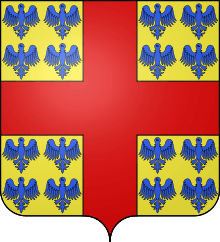House of Montmorency
.jpg)

Montmorency, pronounced [mɔ̃.mɔ.ʁɑ̃.si], is one of the oldest and most distinguished noble families in France.
Origins
The family name Montmorency derived from the city of Montmorency, now in the Val-d'Oise département, in the immediate neighborhood of Enghien-les-Bains and Saint-Denis, about 15 km (9 mi) northwest of Paris.[1]
History
The family, since its first appearance in history in the person of Bouchard I of Montmorency in the 10th century, has furnished six constables and twelve marshals of France, several admirals and cardinals, numerous grand officers of the Crown and grand masters of various knightly orders. Henry IV of France once said, that if ever the House of Bourbon should fail (i.e., become extinct), no European family deserved the French crown better than the House of Montmorency. Bouchard I's son Thibaud of Montmorency was the ancestor of the lords of Montlhéry.[1]
Matthieu I of Montmorency received in 1138 the post of constable, and died in 1160. His first wife was Aline, the natural daughter of Henry I of England; his second, Adelaide de Maurienne, widow of Louis VI and mother of Louis VII, and according to Duchesne, he shared the regency of France with Suger, during the absence of the latter king on the Second Crusade.[1]
Matthieu II of Montmorency had an important share in the victory of Bouvines (1214). As he captured 12 enemy flags at Bouvines, he was permitted by the king to display 12 eagles on his coat of arms. He was also made constable in 1218. During the reign of Louis VIII he distinguished himself chiefly in the south of France (Niort, La Rochelle, Bordeaux). On the accession of Louis IX, he was one of the chief supports of the queen-regent Blanche of Castile, and was successful in reducing all the vassals to obedience. He died in 1230.[1]
His younger son, Guy, in right of his mother, became head of the House of Laval. Canada's oldest French-language university, Université Laval, was named after François de Montmorency-Laval, first bishop of New France and founder of the Quebec Seminary, from while Université Laval emerged.[1]
Anne de Montmorency, so named, it is said, after his godmother Anne of Brittany, was the first to attain the ducal title (1551).[1]
His eldest son, François de Montmorency (1530–1579), was married to Diane, natural daughter of Henry II.[1]
Another son, Henri I de Montmorency (1534–1614), who became duc de Montmorency on his brother's death in 1579, had been governor of Languedoc since 1563. As a leader of the party called the Politiques he took a prominent part in the French Wars of Religion. In 1593 he was made constable, but Henry IV showed some anxiety to keep him away from Languedoc, which he ruled like a sovereign prince.[1]
Henri II de Montmorency (1595 – October 30, 1632), son of duke Henry I, succeeded to the title in 1614, having previously been made Grand Admiral. He also was governor of Languedoc. In 1625 he defeated the French Protestant fleet under Soubise, and seized the islands of Ré and Oleron, but the jealousy of Richelieu deprived him of the means of following up these advantages. In 1628-1629 he was allowed to command against the duke of Rohan in Languedoc; in 1630 he defeated the Piedmontese, and captured Carlo Doria, at Avigliana, and took Saluzzo. In the same year he was created marshal. In 1632 he joined the party of Gaston, duke of Orleans, and placed himself at the head of the rebel army, which was defeated by Marshal Henri de Schomberg at Castelnaudary (September 1, 1632); severely wounded, he fell into the enemy's hands, and, abandoned by Gaston, was executed as a traitor at Toulouse on October 30. The title passed to his sister Charlotte-Marguerite, princess of Condé.[1]
From the barons of Fosseux, a branch of the Montmorency family established in Brabant in the 15th century, sprang the seigneurs de Bouteville, among whom was the duellist François de Montmorency-Bouteville, who was beheaded in 1627.[1] His son, François Henri, marshal of France, became duke of Piney-Luxemburg by his marriage with Madeleine Charlotte Bonne Thérèse de Clermont, daughter of Marguerite Charlotte de Luxemburg, duchesse de Piney.[1]
Charles François Frédéric, the son of the marshal, was created Duc de Beaufort in 1688 and duke of Montmorency in 1689.[1]
In 1767 the title of duke of Beaufort-Montmorency passed by marriage to another branch of the Montmorency-Fosseux. This branch becoming extinct in 1862, the title was taken by the duc de Valencay, who belonged to the Talleyrand-Périgord family and married one of the two heiresses of this branch (1864). There were many other branches of the Montmorency family, among others that of the seigneurs of Laval.[1]
Sires of Montmorency
The Sires of Montmorency were:
- Bouchard I of Montmorency (died 981)
- Bouchard II of Montmorency (died 1020)
- Bouchard III of Montmorency
- Hervé of Montmorency (died 1094)
- Bouchard IV of Montmorency (died 1132)
- Matthieu I of Montmorency (died 1160)
- Bouchard V of Montmorency (died 1189)
- Matthieu II of Montmorency (died 1230)
- Bouchard VI of Montmorency (died 1243)
- Matthieu III of Montmorency (died 1270)
- Matthieu IV of Montmorency (died 1305)
- Jean of Montmorency (died 1325)
- Charles of Montmorency (died 1381)
- Jacques of Montmorency (died 1414)
- Guillaume of Montmorency (died 1531)
- Anne of Montmorency (died 1567)
- Henri I of Montmorency (died 1614)
- Henri II of Montmorency (died 1632)
Notes
References
- Attribution
 This article incorporates text from a publication now in the public domain: Chisholm, Hugh, ed. (1911). "Montmorency". Encyclopædia Britannica. 11 (11th ed.). Cambridge University Press. p. 787.
This article incorporates text from a publication now in the public domain: Chisholm, Hugh, ed. (1911). "Montmorency". Encyclopædia Britannica. 11 (11th ed.). Cambridge University Press. p. 787.
Further reading
- Dictionnaire de la Noblesse, 1865